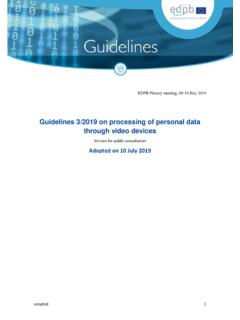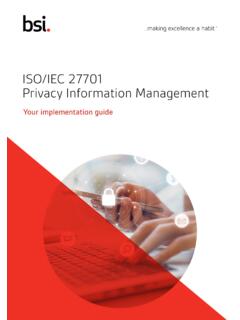Transcription of ARTICLE 29 DATA PROTECTION WORKING PARTY
1 ARTICLE 29 data PROTECTION WORKING PARTY This WORKING PARTY was set up under ARTICLE 29 of Directive 95/46/EC. It is an independent European advisory body on data PROTECTION and privacy. Its tasks are described in ARTICLE 30 of Directive 95/46/EC and ARTICLE 15 of Directive 2002/58/EC. The secretariat is provided by Directorate C (Fundamental Rights and Union Citizenship) of the European Commission, Directorate General Justice, B-1049 Brussels, Belgium, Office No MO-59 02/013. Website: 0829/14/EN WP216 Opinion 05/2014 on Anonymisation Techniques Adopted on 10 April 2014 2 THE WORKING PARTY ON THE PROTECTION OF INDIVIDUALS WITH REGARD TO THE PROCESSING OF personal data set up by Directive 95/46/EC of the European Parliament and of the Council of 24 October 1995, having regard to Articles 29 and 30 thereof, having regard to its Rules of Procedure, HAS ADOPTED THE PRESENT OPINION: 3 EXECUTIVE SUMMARY In this Opinion, the WP analyses the effectiveness and limits of existing anonymisation techniques against the EU legal background of data PROTECTION and provides recommendations to handle these techniques by taking account of the residual risk of identification inherent in each of them.
2 The WP acknowledges the potential value of anonymisation in particular as a strategy to reap the benefits of open data for individuals and society at large whilst mitigating the risks for the individuals concerned. However, case studies and research publications have shown how difficult it is to create a truly anonymous dataset whilst retaining as much of the underlying information as required for the task. In the light of Directive 95/46/EC and other relevant EU legal instruments, anonymisation results from processing personal data in order to irreversibly prevent identification. In doing so, several elements should be taken into account by data controllers, having regard to all the means likely reasonably to be used for identification (either by the controller or by any third PARTY ). Anonymisation constitutes a further processing of personal data ; as such, it must satisfy the requirement of compatibility by having regard to the legal grounds and circumstances of the further processing.
3 Additionally, anonymized data do fall out of the scope of data PROTECTION legislation, but data subjects may still be entitled to PROTECTION under other provisions (such as those protecting confidentiality of communications). The main anonymisation techniques, namely randomization and generalization, are described in this opinion. In particular, the opinion discusses noise addition, permutation, differential privacy, aggregation, k-anonymity, l-diversity and t-closeness. It explains their principles, their strengths and weaknesses, as well as the common mistakes and failures related to the use of each technique. The opinion elaborates on the robustness of each technique based on three criteria: (i) is it still possible to single out an individual, (ii) is it still possible to link records relating to an individual, and (iii) can information be inferred concerning an individual?
4 Knowing the main strengths and weaknesses of each technique helps to choose how to design an adequate anonymisation process in a given context. Pseudonymisation is also addressed to clarify some pitfalls and misconceptions: pseudonymisation is not a method of anonymisation. It merely reduces the linkability of a dataset with the original identity of a data subject, and is accordingly a useful security measure. The Opinion concludes that anonymisation techniques can provide privacy guarantees and may be used to generate efficient anonymisation processes, but only if their application is engineered appropriately which means that the prerequisites (context) and the objective(s) of the anonymisation process must be clearly set out in order to achieve the targeted anonymisation while producing some useful data . The optimal solution should be decided on 4 a case-by-case basis, possibly by using a combination of different techniques, while taking into account the practical recommendations developed in this Opinion.
5 Finally, data controllers should consider that an anonymised dataset can still present residual risks to data subjects. Indeed, on the one hand, anonymisation and re-identification are active fields of research and new discoveries are regularly published, and on the other hand even anonymised data , like statistics, may be used to enrich existing profiles of individuals, thus creating new data PROTECTION issues. Thus, anonymisation should not be regarded as a one-off exercise and the attending risks should be reassessed regularly by data controllers. 5 1 Introduction While devices, sensors and networks create large volumes and new types of data , and the cost of data storage is becoming negligible, there is a growing public interest in and demand for the re-use of these data . 'Open data ' may provide clear benefits for society, individuals and organisations, but only if everybody s rights are respected to the PROTECTION of their personal data and private life.
6 Anonymisation may be a good strategy to keep the benefits and to mitigate the risks. Once a dataset is truly anonymised and individuals are no longer identifiable, European data PROTECTION law no longer applies. However, it is clear from case studies and research publications that the creation of a truly anonymous dataset from a rich set of personal data , whilst retaining as much of the underlying information as required for the task, is not a simple proposition. For example, a dataset considered to be anonymous may be combined with another dataset in such a way that one or more individuals can be identified. In this Opinion, the WP analyses the effectiveness and limits of existing anonymisation techniques against the EU legal background of data PROTECTION and provides recommendations for a cautious and responsible use of these techniques to build a process of anonymisation.
7 2 Definitions & Legal Analysis Definitions in the EU Legal Context Directive 95/46/EC refers to anonymisation in Recital 26 to exclude anonymised data from the scope of data PROTECTION legislation: Whereas the principles of PROTECTION must apply to any information concerning an identified or identifiable person; whereas, to determine whether a person is identifiable, account should be taken of all the means likely reasonably to be used either by the controller or by any other person to identify the said person; whereas the principles of PROTECTION shall not apply to data rendered anonymous in such a way that the data subject is no longer identifiable; whereas codes of conduct within the meaning of ARTICLE 27 may be a useful instrument for providing guidance as to the ways in which data may be rendered anonymous and retained in a form in which identification of the data subject is no longer possible.
8 1 Close reading of Recital 26 provides a conceptual definition of anonymisation. Recital 26 signifies that to anonymise any data , the data must be stripped of sufficient elements such that the data subject can no longer be identified. More precisely, thet data must be processed in such a way that it can no longer be used to identify a natural person by using all the means likely reasonably to be used by either the controller or a third PARTY . An important factor is that the processing must be irreversible. The Directive does not clarify how such a de-identification process should or could be performed2. The focus is on the outcome: that data should be such as not to allow the data subject to be identified via all likely and reasonable means. Reference is made to codes of conduct as a tool to set out possible 1 It should be noted, in addition, that this is the approach also followed in the draft EU data PROTECTION Regulation, under Recital 23 to determine whether a person is identifiable, account should be taken of all the means likely reasonably to be used either by the controller or by any other person to identify the individual.
9 2 This concept is elaborated further on p. 8 of this Opinion. 6 anonymisation mechanisms as well as retention in a form in which identification of the data subject is no longer possible . The Directive thus clearly sets a very high standard. The e-Privacy Directive (Directive 2002/58/EC) also refers to anonymisation and anonymous data very much in the same regard. Recital 26 states that: Traffic data used for marketing communications services or for the provision of value added services should also be erased or made anonymous after the provision of the service . Accordingly, ARTICLE 6(1) states that: Traffic data relating to subscribers and users processed and stored by the provider of a public communications network or publicly available electronic communications service must be erased or made anonymous when it is no longer needed for the purpose of the transmission of a communication without prejudice to paragraphs 2, 3 and 5 of this ARTICLE and ARTICLE 15(1).
10 Under ARTICLE 9(1), moreover: Where location data other than traffic data , relating to users or subscribers of public communications networks or publicly available electronic communications services, can be processed, such data may only be processed when they are made anonymous, or with the consent of the users or subscribers to the extent and for the duration necessary for the provision of a value added service. The underlying rationale is that the outcome of anonymisation as a technique applied to personal data should be, in the current state of technology, as permanent as erasure , making it impossible to process personal Legal Analysis Analysis of the wording related to anonymisation in the leading EU data PROTECTION instruments allows highlighting four key features: - Anonymisation can be a result of processing personal data with the aim of irreversibly preventing identification of the data subject.


















